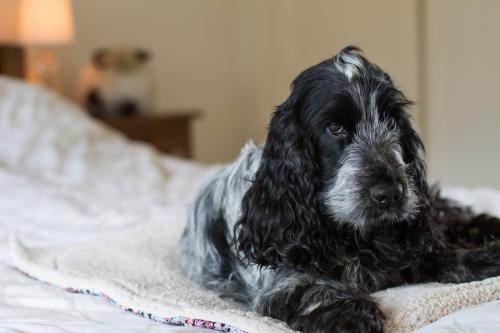If a previously trained dog urinates inappropriately, more often, than usual, or in the wrong place, you may be disappointed and annoyed, and most likely want to punish your dog. But, before acting impulsively, remember that best friend a person devotes his whole life to serving people who care about him, and every day tries to make you happy – therefore, he It’s unlikely to do something contrary to you consciously. Urinary incontinence may be a sign of one of many possible health problems or care, and it’s important to get to the root cause why your dog is urinating incorrectly and take appropriate action – which should rather be expressed by an appeal to the veterinarian and treatment than insult or any other punishment dogs.

Urinary incontinence
Contents
Urinary incontinence due to involuntary or uncontrolled leakage of urine from the bladder, and does not apply to normal urination caused by a lack of training, or urination “humility” (when a dog urinates because of fear, insecurity, or unrest due to another dog or person). Involuntary urination usually occurs in older dogs when they begin to lose control of the bladder, this condition classified as urinary incontinence. If an old dog urinates wrong because of another dog, or because she forgot when and where to go to the toilet, this is another problem that does not classified as urinary incontinence.
Causes of Dog Incontinence
There are a number of possible causes of urinary incontinence in dogs, therefore, the owner should work with the veterinarian to find out the true cause and respond accordingly. Listed below are some of the most common causes. incontinence.
- Bladder infection can lead to a dog will feel an unstoppable urge to urinate often and if she will not be treated for a long time, this will lead to bladder scarring, which in turn can lead to the impossibility of urine retention and its constant leakage.
- Excessive water intake can also cause incontinence. urine, which may be due to various reasons, such as kidney problems, diabetes, hyperthyroidism or syndrome Cushing’s.
- Urinary incontinence can lead to a weakening of the muscles of the urinary bubble due to the aging of the dog, which means that your dog will unable to hold bladder contents for long time and will urinate improperly, or what happens more often, he will suddenly lose control of him.
- Weakening of the sphincter muscles can occur for various reasons, in including due to dog obesity, old age and other factors. Such the condition is especially common in bitches and happens approximate with every fifth bitch when she gets old. Early spaying and sterilization can also be the cause of this conditions since early sterilization stops production estrogen, which plays a role in the bladder and urinating. Low estrogen incontinence may occur at any time during the life of the dog, starting immediately after sterilization and until many years later.
- Back problems such as lower lumbar damage area or area of the pelvis, abnormal development of the spinal cord and muscle, and genetic predisposition to abnormal development may affect your dog’s ability to control urinary bubble. Dog incontinence often develops due to acquired injuries such as accidents and the like incidents in which the spine, pelvis or back are damaged legs.
- Blockage of the urethra caused by stones or swelling, can lead to incontinence. Channel blocking can mean that the dog is not able to completely empty the urinary bubble.
- Birth defects such as an ectopic ureter – rare a defect in which the ureters that carry urine in the urine bladder from the kidneys do not actually enter the bladder due to improper development and lead to regular slow leakage urine. This condition is especially common in breeds such as Siberian Husky, miniature poodle, collie, Corgi, Labrador, West Highland White Terrier. A defect usually occurs in bitches, and may affect one or both ureters. If only one is affected the ureter, then the dog is likely to suffer from a lung incontinence, but will be able to urinate normally. When lesions of both ureters, the dog will not be able to urinate normally generally.
- There are several other relatively rare diseases, which lead to urinary incontinence, including vulvar stenosis, with which urine can collect in the vulva and then flow out later. Due to the wide range of potential causes of dog urinary incontinence, it is important that your pet is veterinarily tested and diagnostics to identify the root cause of this condition.
Methods for treating urinary incontinence
The choice of the best treatment method depends on a wide range of different factors including age and gender of the dog, general health, financial constraints and the exact nature and causes of incontinence. AT depending on the final diagnosis, your veterinarian will discuss with you treatment options that may include application antibiotics, infection control, hormone treatment low estrogen incontinence or surgery intervention to remove the tumor or stones and repair defects. Treating or managing diseases like diabetes, which can lead to incontinence is also often presented possible. In some cases, a simple, attentive control the dog at home and minimize the impact on it incontinence.
There is no universal treatment for dog urinary incontinence method, and treatment is often not quick and easy. Talk with your veterinarian, as soon as you find a problem, it will help you maximize the likelihood of a positive outcome and correction problems with your pet.






